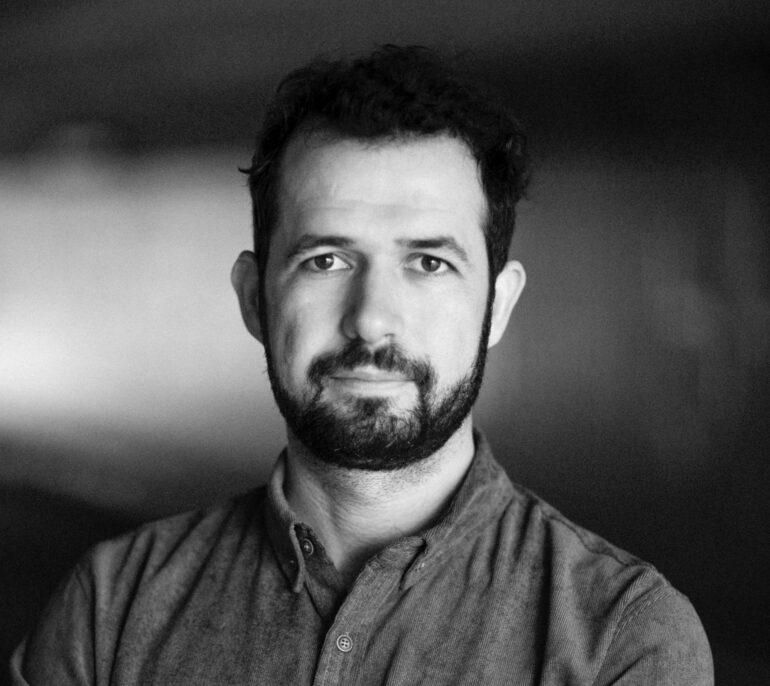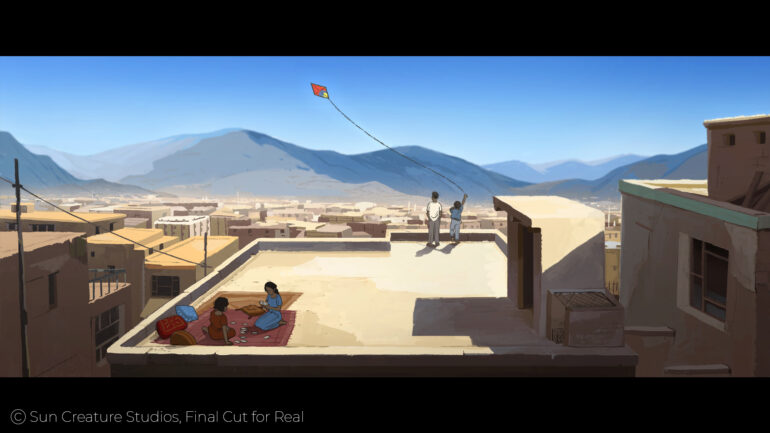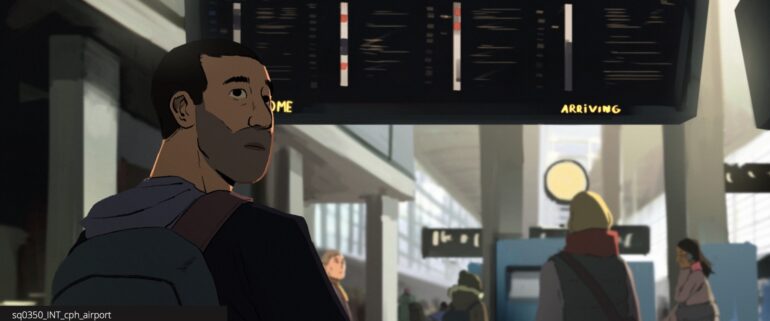WRITTEN BY: Annika Pham
Jonas Poher Rasmussen’s Danish film is the opening film of Sundance World Cinema Documentary Competition strand.
The innovative animated doc Flee is based on a true story. Amin arrived as an unaccompanied minor in Denmark from Afghanistan. Today aged 36, he is a successful academic, soon to be married to his long-time boyfriend. But a secret he has been hiding for over 20 years threatens to ruin his life. For the first time he is sharing his story with his close friend.
Flee received the prestigious Cannes Label last spring and is world premiering January 29 at Sundance. The film was produced by Monica Hellström and Signe Byrge Sørensen of Denmark’s Final Cut for Real, with animation producer Charlotte de la Gournerie of Sun Creature. It was co-produced by France’s Vivement Lundi!, Sweden’s Mostfilm, Norway’s Mer Film, ARTE France and VPRO in The Netherlands, with co-financing among others from DR, SVT, Yle and support from Nordisk Film & TV Fond. Cinephil handles global sales.
Star actors Riz Ahmed and Nikolaj Coster-Waldau have committed to lending their voices for the English-language version, set to premiere later this year.
Flee is based on the real story of your friend Amin. When did you first think about making a film about his life experience, and how did you convince him to open up?
Jonas Poher Rasmussen: I worked in radio for a long time and did a series of radio documentaries for DR when I was in my 20’s. I knew Amin had a dramatic background and at some point, I asked him if he wanted to tell me his story for a radio documentary, but he said that he wasn’t ready to talk about his past. Then years passed by and in 2013 I was invited by the Animation Workshop in Viborg to participate in a workshop called Anidox. They asked me if I had an idea for an animated doc and then I thought about Amin’s story again.
I called him up and told him about the idea of making his story into an animated documentary. He finally said yes to sharing his story for the very first time, also because animation made it possible for him to stay anonymous while diving into his life trauma.
Were you inspired by the animated war documentary Waltz with Bashir?
JPR: Waltz with Bashir is the crown jewel of animated docs, so of course I’ve been inspired by it. The film carved the way for other animated docs and made me understand that animation can bring something extra to documentary stories.
Your previous films Searching for Bill and What He Did also dealt with difficult topics, and you’ve shown earlier your interest to play with the form. Is how you tell a story almost as important as the story itself?
JPR: Yes, almost. I believe that the form should always depend on the story, but how you tell a story is what makes it come alive. When dealing with the past, it’s crucial to make things feel vibrant and relevant again. I have worked with theatre re-enactments, fiction/documentary hybrids and now animation with Flee.
The production notes mention top writers Eskil Vogt (Joachim Trier’s regular collaborator) and Rasmus Heisterberg (The Girl With the Dragon Tattoo) as script consultants. What was their input?
JPR: Rasmus read the script at a very early stage and mostly helped me out with the initial structure, references and advice on how to write a scene. I had a LOT of material. The story takes place during 30+ years and for a long time I continued going back and forth between writing and doing new interviews with Amin, in order to really understand the scope of his story. Eskil was key in helping me navigate through all his material, figuring out which of all the stories were important and which ones we could do without.
Amin and his family’s plight as refugees are heart-breaking, and you’ve described with realism the constant fear to be caught and sent back. Ultimately, is it the trauma of any refugee and perpetual sense of misplacement that you wanted to portray?
JPR: While making Flee, I realised that for Amin, the feeling of displacement was still very acute, even after all these years and I really got new insights into the drastic consequences of fleeing your home, especially as a child. I slowly understood what it’s like to have a deep secret that you cannot share with anyone.
I didn’t realise this before making the film, but coming from a Jewish family, this theme of flight and dislocation is very important to me. My ancestors fled Russia in the early 20th century to escape persecution and pogroms. Like Amin, they sailed across the Baltic to Denmark. This was where my grandmother was born, in a hotel close to the central train station in my current hometown of Copenhagen. Her family – my family – applied for asylum, but they were denied, so they were forced to move again, this time to Germany. As a primary school student in Berlin, my grandmother was then forced to stand before her classmates with a yellow star on her chest and soon, she had to flee again, this time to England. This happened almost a century ago, but the story of her forced displacement still sits in my family.
All of this to say. Yes, I think there is a perpetual sense of misplacement amongst refugees.
There are two different types of animation - if I’m correct. Can you detail the process that went into creating the artistic frame (storyboard, character design, background etc) from which the animators could work?
JPR: Yes we have two types of animation. Mainly the standard 2D animation showing the present-day layer, Amin’s testimony and re-enactment from his past. Secondly, we have the more simple and expressive animation which is used to show whenever Amin talks about something traumatic or something he has a hard time remembering.
All the animation was done by Sun Creature Studios in Copenhagen, lead by animation director Kenneth Ladekjær. Backgrounds and compositing was done at Vivement Lundi in Rennes lead by art director Jess Nicholls while the FX animation, colour and the graphical sequences was developed in collaboration with Simon Rouby and animated by Gilles Cuvelier at Studio Train-Train in Lille.
Creating the visual style for Flee took a very long time. Initially we had art director Guillaume Dousse on board who really lifted the ambitions of the project to another level. He passed the project on to Jess Nicholls who took over as art director. We spent a long time researching, testing techniques, and Jess spent months looking at old books, movies and archive footage to create designs for our locations, props etc.
We had Mikkel Sommer coming in to do the character designs and Mads Juul was leading the storyboard.
Can you explain how you selected archive material to enhance the dramatic elements in the narration?
JPR: It was really ‘just’ about finding the archive that supported Amin’s story. One aspect was the locations. I wanted to show people what Afghanistan really looked like in the 80’s, what Moscow and Copenhagen looked like in the 90’s and then use the archive as a reference when developing our style of animation in order to keep the authentic feel throughout.
Another key aspect was to remind the audience that this is a documentary. I want people to understand that what happens in the film is tied to real historical events, and even though most of the film is animated, it portrays a real lived life.
How was your collaboration with multi-awarded editor Janus Billeskov Jansen (Another Round, The Hunt, Pelle the Conqueror)?
JPR: Janus is the grand-old-man of editing in Denmark and I must admit that I was a little nervous, when we started working together. During the first days in the editing room, we didn’t really get anywhere and at some point, he turned to me and said, ‘Jonas you need to stop being so nice to me and just tell me what you want.’ And from there it started to flow!
Janus is very open-minded and has a very sincere joy of telling stories. Even if he had never worked with animation before, he never stopped and said, that can’t be done. ‘If it works it works’ – he kept telling me.
The editing process is quite different when dealing with animation instead of live action. It’s kind of the other way around. Normally you’re a slave of the footage you bring home from your shoot. But with animation, you don’t actually start ‘shooting/animating’ till the edit is done, and you can always ask for new material (storyboards) in the process, meaning if you are missing a close-up shot or a mood shot of birds flying by for a specific scene, then you just draw it. This meant that suddenly, there where infinite possibilities when it came to solving a scene, which was mind-blowing to me.
How was your collaboration with your producer Monica Hellström?
JPR: I met Monica more than 17 years ago, when we met at the Copenhagen Film Workshop, but this is our first project together. I had this idea for the film and I really wanted to have Final Cut for Real on board, when I randomly met Monica at a seminar. I pitched the idea and luckily, she liked it. That’s 7 years ago now. Since then Monica has done an absolutely amazing job financing this utopian project. Animation is expensive and there isn’t a lot of money for documentaries, so it’s been a steep climb. But somehow Monica seems to just work harder when things get tough. She has also been a big part of the creative process as she has really good taste and strong opinions.
What’s next?
JPR: I'm writing a script for another animated feature based on a Danish graphic novel called Dansker Trilogien (The Dane Trilogy) by Halfdan Pisket. We are in the very early stages.


